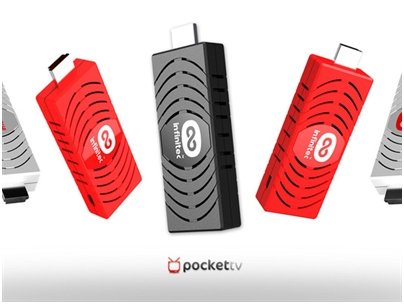
Smart TV technology is all the rage, and two companies that came to prominence through their investment opportunities as presented by Kickstarter are leading the way into this exciting new tech sector.
Here’s a comparison of the Equiso Smart TV and the Infinitec Pocket TV, which are so similar it could come down to cost.
How They Connect
Both products are essentially the size of a standard USB thumb drive, and have a standard male HDMI connector designed to fit into any HDMI port. The Equiso Smart TV uses HDMI version 1.4 giving it the ability to stream 3-D programming. Pocket TV uses HDMI version 1.3 which does not allow for 3-D.
How they operate
Both iterations run on Google’s Android 4.0 operating system, known as Ice Cream Sandwich. No word on whether or not Infinitec will upgrade to version 4.1 (Jelly Bean), but Equiso is reported to be working closely with Google to ensure a smooth transition upon release of the OS upgrade.
Memory and Storage
Both devices offer an adequate amount of both memory and storage, which will make the choice one of personal preference. Equiso Smart TV comes with 512MB of memory in its basic configuration and bumps that to 1GB in the Pro model. Either comes standard with 8GB of internal storage. The Pocket TV comes standard with 1GB of memory and 4GB of internal storage.
CPU and GPU
The processing capabilities of the two devices spells the biggest differences between them. When it comes to graphics, the Pocket TV uses the excellent Mali-400MP Graphics Processor, giving viewers a truly smooth an excellent viewing experience. Equiso Smart TV went with Mali as well, choosing the 400 3-D graphic processor because of its ability to stream 3-D content.
The central processing units, however, are considerably different. Infinitec went with the 1GHz ARM Cortex A9 CPU, which has been known to overheat in small packages. Testing indicates it can only operate at 600 MHz inside such a small package to avoid the issue of overheating after a couple of hours of continuous use.
Conversely, Equiso chose the 1GHz ARM Cortex A5 CPU, which can operate at a full 1Ghz without overheating in this particular usage, which Equiso developers say will make a big difference when it comes to its Smart TV product’s ability to process complex commands.
 Remote Controls
Remote Controls
This is another area where user preference could ultimately decide which product is the right one. The Infinitec Pocket TV offers two versions, including a “wired” infrared remote as a part of the standard package, or an upgrade to a full-QWERTY keyboard wireless version. The infrared remote is very simple and offers a limited range of features.
The Equiso Smart TV offers a unique, two-sided wireless remote in all packages. On one side is a simple “gesture” remote that controls page content in much the same way as they’re controlled on smartphones and tablets. On the reverse side is a full-QWERTY keyboard when the need arises.
Networking and Additional Features
Both versions offer wireless networking, with only slightly different configurations. The Equiso Smart TV comes standard with 802.11 N wireless radio and the Infinitec Pocket TV offer 802.11 b/g/n wifi to ensure its compatibility with the widest range of wireless protocols possible
Both devices also offer additional features. The Equiso Smart TV includes a USB 2.0 Plug n’ Play interface. The Infinitec Pocket TV includes the same USB port, plus a mini USB power port and a MicroSD slot for a maximum of 32GB of additional storage for movies, videos, music, and other content.
Price and Availability
The Equiso Smart TV will be available beginning in August 2012. It will offer its basic package for $69 then, with the Pro package due in October 2012 for $99.
The Infinitec Pocket TV will be available in October 2012. The basic version with the infrared remote control will be available at a cost of $129, with a $20 bump to $149 for the wireless version.
Regardless of which way you go, smart TV products are about to change the way we watch television by turning our HDTVs into Android-based “smart” TVs, giving us access to millions of apps for the Android operating system.
About the Author: Justin is a sports, marketing and tech enthusiast. When not in the stands watching University of Utah football you can find him writing and blogging for DirecTV





